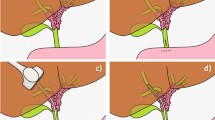Abstract
Accurate knowledge of partial anatomy is essential in hepatic surgery but is difficult to acquire. We describe the potential impact of a new technique for constructing three-dimensional virtual images of the portal vein, hepatic artery, and bile ducts and present a representative case. An 80-year-old man was suspected of having papillary cholangiocarcinoma arising in S8 of the liver and extending to the hepatic hilum intraluminaly. Right hemihepatectomy with bile duct resection was planned. However, it was uncertain whether duct-to-duct biliary reconstruction would be possible based on the appearance of the confluence of the right and left hepatic ducts on cholangiogram and conventional computed tomograph. Virtual three-dimensional images of the liver were constructed and revealed vascular and biliary anatomy. They showed that the upper margin of bile duct excision would be 19 mm from the umbilical point of the left portal vein, and that the site of the left branch of the caudate lobe bile duct could be preserved. Based on this information, we performed a sphincter-preserving biliary operation safely without complications. Planning complex biliary surgery may be improved by the use of virtual three-dimensional images of the liver. This approach is especially useful in candidates for postoperative regional chemotherapy.





Similar content being viewed by others
References
Jarnagin WR, Gonen M, Fong Y, DeMatteo RP, Ben-Porat L, Little S, Corvera C, Weber S, Blumgart LH. Improvement in perioperative outcome after hepatic resection. Analysis of 1803 consecutive cases over the past decade. Ann Surg 2002;236: 397–407.
Kondo S, Hirano S, Ambo Y, Tanaka E, Okushiba S, Morikawa T, et al. Forty consecutive resections of hilar cholangiocarcinoma with no postoperative mortality and no positive ductal margins. Results of a prospective study. Ann Surg 2004;240:95–101.
Fortner JG, Kallum BO, Kim DK. Surgical management of carcinoma of the junction of the main hepatic ducts. Ann Surg 1976;184:68–73.
Lang H, Radtke A, Liu C, Fruhauf NR, Peitgen HO, Broelsch CE. Extended left hepatectomy—modified operation planning based on three-dimensional visualization of liver anatomy. Langenbeck’s Arch Surg 2004;389:306–310.
Healey JE Jr, Schroy PC. Anatomy of the biliary ducts within the human liver; analysis of the prevailing pattern of branchings and the major variations of the biliary ducts. AMA Arch Surg 1953; 66:599–616.
Couinaud C. Surgical Anatomy of the Liver Revisited. Paris: Couinaud, 1989.
Blumgart LH, Hann LE. Surgical and radiological anatomy of the liver and biliary tract. In Blumgart LH, Fong Y, eds. Surgery of the Liver and Biliary Tract, 3rd edn. London, Edinburgh, New York, Philadelphia: WB Saunders Co, 2000, pp 3–34.
Pozniak MA, Babel SG, Trump DL. Complications of hepatic arterial infusion chemotherapy. Radiographics 1991;11:67–79.
de Baere T, Roche A, Amenabar JM, Lagrange C, Ducreux M, Rougier P, Elias D, Lasser P, Patriarche C. Liver abscess formation after local treatment of liver tumors. Hepatology 1996;23:1436–1440.
Kasahara M, Egawa H, Takada Y, Oike F, Sakamoto S, Kiuchi T, Yazumi S, Shibata T, Tanaka K. Biliary reconstruction in right lobe living-donor liver transplantation. Comparison of different techniques in 321 recipients. Ann Surg 2006;243:559–566.
Schroeder T, Radtke A, Kuehl H, Debatin JF, Malago M, Ruehm SG. Evaluation of living liver donors with an all-inclusive 3D multi-detector row CT protocol. Radiology 2006;238:900–910.
Lang H, Radtke A, Hindennach M, Schroeder T, Fruhauf NR, Malago M, Bourquain H, Peitgen HO, Oldhafer KJ, Broelsch CE. Impact of virtual tumor resection and computer-assisted risk analysis on operation planning and intraoperative strategy in major hepatic resection. Arch Surg 2005;140:629–638.
Wald C, Bourquain H. Role of new three-dimensional image analysis techniques in planning of live donor liver transplantation, liver resection, and intervention. J Gastrointest Surg 2006;10: 161–165.
Nagano Y, Togo S, Tanaka K, Masui H, Endo I, Sekido H, Nagahori K, Shimada H. Risk factors and management of bile leakage after hepatic resection. World J Surg 2003;27:695–698.
Furukawa H, Sano K, Kosuge T, Shimada K, Yamamoto J, Ishii H, Iwata R, Ushio K. Analysis of biliary drainage in the caudate lobe of the liver: comparison of three-dimentional CT cholangiography and rotating cine cholangiography. Radiology 1997; 204:113–117.
Kubo M, Sakamoto M, Fukushima N, Yachida S, Nakanishi Y, Shimoda T, Yamamoto J, Moriya Y, Hirohashi S. Less aggressive features of colorectal cancer with liver metastases showing macroscopic intrabiliary extension. Pathol Int 2002;52:514–518.
Yamamoto M, Takasaki K, Yoshikawa Y, Ueno K, Nakano M. Does gross appearance indicate prognosis in intrahepatic cholangiocarcinoma? J Surg Oncol 1998;69:162–167.
Minagawa M, Makuuchi M, Takayama T, Kokudo N. Surgical approach to liver metastasis with hepatic hilar invasion. Hepatogastroenterology 2004;51:1467–1469.
Author information
Authors and Affiliations
Corresponding author
Rights and permissions
About this article
Cite this article
Endo, I., Shimada, H., Takeda, K. et al. Successful Duct-to-duct Biliary Reconstruction after Right Hemihepatectomy. Operative Planning Using Virtual 3D Reconstructed Images. J Gastrointest Surg 11, 666–670 (2007). https://doi.org/10.1007/s11605-007-0130-2
Published:
Issue Date:
DOI: https://doi.org/10.1007/s11605-007-0130-2




